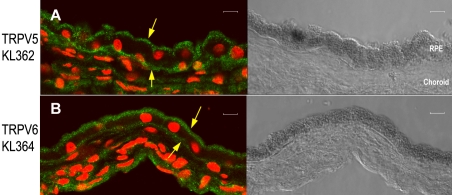Figure 3.
Immunolocalization of transient receptor potential vanilloid channels, TRPV5 and TRPV6, in frozen sections of native human retinal pigment epithelium/choroid tissue. Tissue orientation in all panels shows the retinal pigment epithelium (RPE) monolayer above the choroid tissue. In the fluorescent images (left two panels), TRPV5 immunoreactivity (A) and TRPV6 immunoreactivity (B) appear green; nuclei (red) were visualized with TO-PRO-3; corresponding differential interference contrast (DIC) images (panels on the right) show the pigmented RPE monolayers. In A, the anti-TRPV5 antibody used was KL362 (affinity-purified polyclonal antibody, final concentration 2.5 µg/ml). In B, the anti-TRPV6 antibody used was KL364 (affinity-purified polyclonal antibody, final concentration 2.5 µg/ml). The secondary antibody used in both panels was antirabbit immunoglobulin G (IgG) conjugated to Alexa 488 (final dilution 1:500). Down arrows in both panels identify prominent staining on or just below the apical plasma membrane; up arrows identify prominent staining along the basal plasma membrane. Sections are from a 47-year-old Caucasian female donor. The pattern of staining in these panels is representative of staining observed on sections from four different donors (three female, one male, ranging in age from 47 to 79 years). Scale bars in all panels represent 10 µm.

